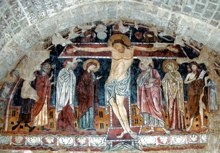


Crucifixion with the Virgin and
SS Severus (damaged), Augustine, Mary Magdalene,
John the Evangelist, Elizabeth, John the Baptist and Martirius (lost)
Fresco (13th century) in SS Severo e Martirio
Two entries in the Roman Martyrology probably relate to this saint:
-
✴under 15th February: “In the province of Valeria, St Severus, priest, of whom St. Gregory says that by his tears he recalled a dead man to life”; and
-
✴under 1st October: “At Orvieto, St Severus, priest and confessor”.
The Abbazia di SS Severo e Martirio outside Orvieto is dedicated to SS Severus and Martirius.
Dialogues of Pope Gregory I
These two men are mentioned in successive stories in the Dialogues of Pope Gregory I:
Book I, Chapter 11: of Martirius, a Monk in the Province of Valeria
This short chapter recounts the evidence of a monk called Martirius who lived in the province of Valeria (now the Abruzzi). One day, when the other monks were baking bread under the ashes, they forgot to mark the loaves with a cross. Martirius therefore traced a cross on the ashes themselves with a cross. After the bread “was baked and taken out, the monks found it marked with the sign of the cross, which yet not any corporal touching, but the faith of Martirius had imprinted”.
Book I, Chapter 12: of Severus, a Priest in the same Province
This chapter relates to a parish priest called Severus who lived “in a valley that is called of the plain people Interocrina”, in the province of Valeria. The account records that he delayed visiting a dying man (because he was busy in his vineyard) and therefore failed to give him extreme unction before he died. On hearing of the death, “the good man fell a trembling, and cried out aloud that he had killed him; whereupon he fell a weeping, and in that manner came to the dead corpse ... suddenly the dead man returned to life” He recounted that, as he had been taken “ through dark places, suddenly a beautiful young man with others met us, who said ... 'Carry him back again; for Severus the Priest laments his death, and our Lord, for his tears, hath given him longer life'.” Severus duly administered the sacrament, and the man died again having confessed his sins.
Codex Urbevetanus (13th century)
This two-volume legendary (collection of saints’ lives) in the Cathedral Archives contains separate accounts of the lives of SS Severus and Martirius.
Section on St Martirius
This section adds two stories about St Martirius to the one in the Dialogues, both of which derive from the account in the “homilia in Evangelia” of Pope Gregory I that relate to a saint of the same name from Licaonia (in Asia Minor):
-
✴he once carried coals in his clothes to warm himself and his colleagues as they watched over their flocks, and the clothes were miraculously unburned; and
-
✴on another occasion, he succoured a leper who turned out to be Christ.
The account in the codex specifically names Martirius as a disciple of “beatus Severus”, and describes both men as monks who lived in the same monastery.
Section on St Severus
This section repeats the miracle from the Dialogues, and adds a posthumous miracle: after the death of St Severus at Interocrium (Antrodoco) a dispute broke out about his remains. Divine intervention prompted the inhabitants to place the body on a cart driven by untamed oxen and to bury it where the animals chose to stop. A lady called Rotruda tried to stop the cart as it approached Orvieto, but her hand stuck to the coffin. Only when she begged forgiveness from St Severus and offered him a place of burial on her land, near a church dedicated as San Silvestro, was she freed.
Their supposed relics, which were presumably originally in SS Severo e Martirio, were subsequently moved to the sacristy of Sant' Angelo: this church belonged to the abbey, and it is likely that the monks moved the relics here for security during a violent period (of which there were many). An attempt was made to steal the reliquary in July 2011, but the stolen objects were, fortunately, recovered.
Cult of SS Severus and Martirius at Orvieto
Before the two saints were linked in the Codex Urbevetanus, the abbey outside Orvieto was variously referred to as San Severo or SS Martirio e Maurizio. The dedication as SS Severo e Martirio and the writing of the accounts in the Codex Urbevetanus probably date to 1220, when the abbey was transferred from the Benedictines to the Premonstratensian canons.
The date chosen for the feast of St Severus in Orvieto (1st October) is also the date of the translation to Trier in the 10th century of the presumed relics of the St Severus whose feast day is 15th February (St Severus of Munstermaifeld, whose relics are now in SS Martin and Severus there). This suggests that the two entires in the Roman Martyrology involve duplication.
The supposed relics of SS Severus and Martirius in Orvieto, which were originally in SS Severo e Martirio, were moved to Sant' Angelo (which belonged to the abbey) in 1613, presumably for greater security. They were placed in a new reliquary, and the high altar of Sant’ Angelo was restored in order to receive it. The old reliquary was unfortunately destroyed at this point. An attempt was made to steal the reliquary in July 2011, but the stolen objects were, fortunately, recovered.
Read more:
L. Andreani, “Le Legendae dei Santi Severo e Martirio del Codex Urbevetanus ”, in
P. Pellegrini (Ed.), “Storia, Archeologia e Arte nell' Umbria Meridionale: Studi in Memoria di Cinzia Perissinotto”, (2009) Perugia, pp 129-40
Return to Saints of Orvieto.

